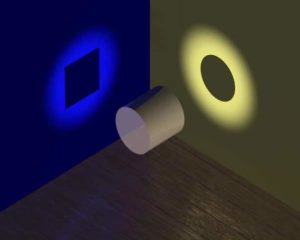
Sensory clarity: Liberation through details and overview
Good sensory clarity is like standing on a mountain at noon, with good visibility and a view of all movements below and above you. Everything is unclouded, luminous, crystal clear.
That is, this is how sensory clarity appears in the sense of sight. But we can have clarity in all the senses and in all of our experience.
Sensory clarity is the ability to distinguish between the different parts of what we experience. We can also say that it is the ability to keep track of and explore the sensory experience in the moment.
This is a skill we all have, and there are good reasons why we want to develop it more. That’s why we place great emphasis on sensory clarity in our mindfulness method.
Three reasons to develop good sensory clarity
What are the benefits of developing better sensory clarity?
Here are some:
1. Sensory clarity leads to insight

Insight awaits us everywhere if we know where to look.
If you are bored, you may be thinking, “Now I’m bored. What can I do so that I am not bored anymore? ”
With sensory clarity, you can notice that boredom is a physical feeling in your body that is linked to inner speech, such as the phrase, “I get bored.”
When you notice the physical sensation, you may notice that you have a feeling in your stomach (restlessness), in your eyes (which will close) or in your jaw (which will yawn), but it is not necessarily your whole body or your mind that is bored.
In this way, boredom becomes something that is interesting and explorable. And what was once a waste of time is no longer a problem. It will be an opportunity.
2. Sensory clarity helps against overwhelm
If you are overwhelmed by anxiety, anger or stress, you often experience it as something big, intangible and solid. These are emotions that are often intertwined with thoughts, perceptions and interpretations.
If you bring sensory clarity to these experiences, you will see that everything consists only of inner images, inner speech and emotions that appear in a certain order.
For example, you may find that what at first seemed like overwhelming stress was actually just an experience of seeing (a picture of your cluttered desk) combined with hearing (the thought “I’ll never finish this on time!”) Combined with a feeling (raised shoulders and clenched teeth coming from anxiety).
When you divide your experience in this way, the different parts do not feed on each other as they did. This makes the experience much more affordable. The result is that you feel less trapped and stuck.
3. Sensory clarity opens up new perspectives
Often we are not able to see new sides of something because we are locked in by subconscious processes. By practicing sensory clarity, we become more aware of both what separates sensory experiences from each other, and what unites them.
In this way, we can become more aware of how certain categories or points of view are useful or useless to us.
Let’s take some categories: Old and young. Work and leisure. Sick and healthy. Nature and society. What do these seemingly contradictory terms really mean? Is it possible that they are not as contradictory as it seems?
Many categories are useful sometimes. But what happens if we dissolve them for a while and look at them from a different point of view? What do we learn then?
How do we train sensory clarity?
We train sensory clarity by being aware of it every time we meditate and in everyday life.
Sensory clarity has two sides: sensitivity and resolution.
Sensitivity
By sensitivity we mean the capacity to detect subtle signals, heed volatile events and follow something that is constantly changing.
For example, when you notice that your attention is shifting from place to place, you are sensitive to how the sensory experience is changing at the moment. You are sensitive to exactly what is happening the moment your attention changes, and not right afterwards.
Labeling increases sensitivity. When you put a label on what you see, hear or feel, you become clearer about what you are experiencing in a given moment. When you do this, it increases the ability to discern or discover what it is you are experiencing.
Another technique that specifically trains sensitivity is to notice vanishings
Resolution
Here it will be quite technical and detailed, and that is the whole point. We will both improve our technique and be able to notice the details of what we experience.
By resolution we mean the capacity to distinguish between qualitative, quantitative and spatial differences in our experience. What does it consist of? How much? Where?
It’s like a TV screen or a YouTube movie. With high resolution we can see many different colors, depth in the image and small details. With too low a resolution, everything just becomes porridge.
We divide all sensory experience into three main categories: sight, hearing and feeling (smell and taste are included in feeling for the sake of simplicity). With a little experience, we then divide these sensory rooms into several important categories, such as active or resting.
For example, when you are aware of a feeling in your body you may notice:
Spatial distinctions – where?
- where is the feeling in the body?
- … Or does it consist of several parts around?
- what three-dimensional shape does it have?
- … Or the different parts?
- does the feeling have a center?
- does it have an outer limit?
Qualitative distinctions – what?
- What quality does the feeling have?
- Is it active or resting?
- Does it have temperature, pressure, or motion?
Quantitative distinctions – how much?
- How intense is the feeling?
- How intense is it at the outer limits?
- Does the intensity change?
- Does the change have a rhythm?
What if you do not have that much sense clarity?
Sometimes we do not have much sensory clarity available.
Maybe it’s because there is not enough room in the consciousness to be able to approach a given sense with a magnifying glass. It is quite simple because there is only a limited amount of space in consciousness. And that’s okay.
Or maybe we have a day with a lot of distractions or other stress. The sense clarity we had yesterday is just a faded memory.
That’s fine too.
The main point is that we constantly train to strengthen our sensory clarity and that it gets stronger in everyday life.
Because, as Zen master Hakuyu Taizan Maezumi said, “Details are all there are.”
Thanks to Julianna Raye @ unifiedmindfulness.com